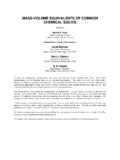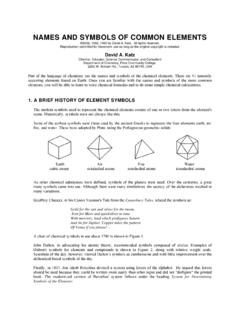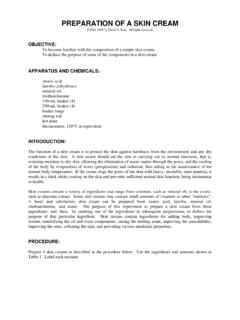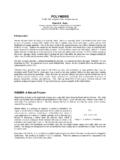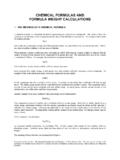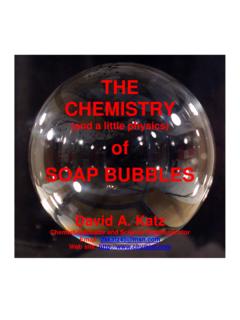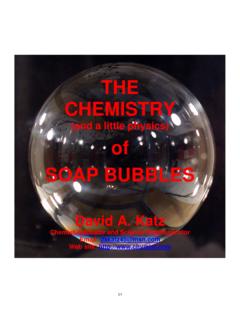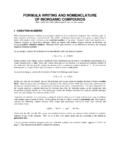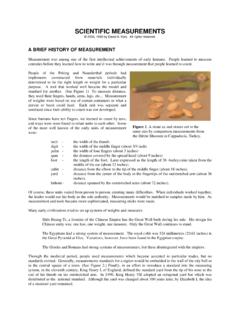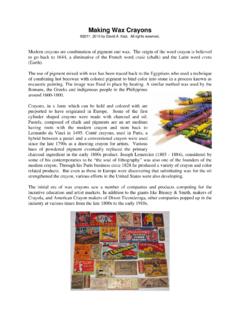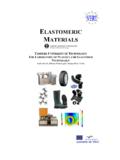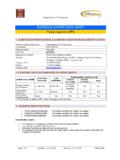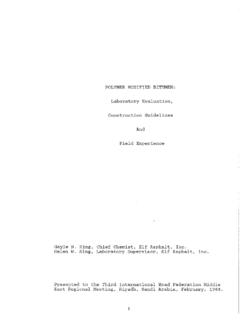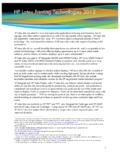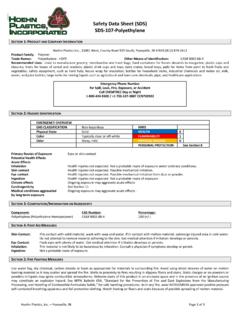Transcription of Identification of Polymers - chymist.com
1 Identification OF Polymers 1998 by David A. Katz. All rights reserved David A. Katz Chemist, Educator, Science Communicator, and Consultant 133 N. Desert Stream Dr., Tucson, AZ 85745 Voice/Fax: 520-624-2207 Email: Introduction In our everyday life, we encounter many polymeric materials, many of which are in the form of disposable containers used for many household products. As our natural resources are diminished and our landfills become filled1, we are finding that it is better to recycle much of our waste materials than to dispose of them or burn them. Most of the Polymers we encounter in our daily lives are the six Polymers listed in Table 1.
2 To make recycling of these Polymers easier, the plastics industry has adopted the codes shown. Since compliance in labeling is voluntary, not all plastics are labeled for Identification . Identification , simply by appearance, is difficult, however, there are a few types that are readily identifiable. Clear, colorless containers that are used for soft drinks are most often polyethylene terephthlate (PETE). Opaque, translucent (and often white in color) plastics used for containers such as milk cartons are usually high-density polyethylene (HDPE). Bottles used for shampoos or cleaning materials are usually made from polyvinyl chloride (V or PVC).
3 Plastic bags and some plastic wrap is often made from low-density polyethylene (LPDE). In this experiment, we will examine some common plastics and perform several tests to identify them. A flow chart for the tests is given below: Water test Sinks Floats Copper Wire Test Alcohol Test Green Orange Flame Flame PVC Sinks Floats HDPE Acetone Test Oil Test Reaction No Reaction PS Sinks Floats LDPE PP Heat Test Reaction PETE 1 The major material filling landfills is paper, not Polymers .
4 Materials Needed Samples of resin pellets in vials labeled 1 through 6 2 Unknown samples of plastics (These are in vials labeled 7 through 12) Isopropyl alcohol solution, CH3 CHOHCH3 , by volume. This solution is made by diluting mL isopropyl alcohol to 100 mL with water. (Also, by diluting 65 mL 70% isopropyl rubbing alcohol to 100 mL with water.) Mazola corn oil Copper wire Corks to fit 18 mm test tubes Acetone Test tubes, 18 x 150 mm Stirring rod, glass Bunsen burner Beaker, 50 mL Beaker , 250 mL Tongs or forceps Ring stand and ring with wire gauze Safety Precautions Isopropyl alcohol is flammable and the vapors are considered to be toxic.
5 Keep containers closed and cover any open containers, such as a beaker, with a watch glass. Avoid flames. Acetone is flammable and the vapors are considered toxic. Keep containers closed and cover any beakers of acetone with a watch glass. Work in a well ventilated area. Avoid flames. The copper wire will get hot when heated in a flame. Hold the wire with tongs or forceps to avoid burns. Disposal Dispose of alcohol waste and acetone waste according to local regulations. Mazola corn oil can be reused if it is not dirty or contaminated. Dispose of any waste oil according to local regulations.
6 Waste pieces of plastic can be disposed in the trash. Copper wire can be reused. Experimental Procedure Obtain a set of vials containing the six kinds of recycled plastic resin pellets. Note that each type of resin is a different color. This allows for visual Identification in this experiment. Actual resins may be almost any color depending on colorants added during its initial formulation. Obtain samples of two different unknown Polymers . These will be small pieces of polymer , not pellets. The Water Test Place approximately 5 mL of water in a test tube. Start with one of the six plastic resin pellets.
7 Place two of the pellets of the resin in the test tube containing water. Poke the each of the pellets with a stirring rod to remove any air bubbles adhering to the surface of the resin pellet and try to make it sink. Note whether the pellets sink or float. If both pellets do not behave in the same manner, test a third pellet of the same type and use the results of two that behaved the same way. Remove the pellets, dry them and save them for later use. Repeat the water test with each of the remaining resin samples and with small pieces of the two unknown samples. Save the samples that sank in the water for the copper wire test.
8 Use the samples that floated for the isopropyl alcohol test. The Isopropyl Alcohol Test Place 5 mL of isopropyl alcohol solution in a test tube Using one of the resins that floated in the water, add two pellets to the test tube containing the alcohol solution. Poke each pellet with a stirring rod to remove any air bubbles adhering to the surface of the resin pellet and try to make it sink. Note whether the pellets sink or float. If both pellets do not behave in the same manner, test a third pellet of the same type and use the results of two that behaved the same way. Remove the pellets, dry them and save them for later use.
9 Repeat the isopropyl alcohol test with each of the remaining resin samples and unknowns that floated in the water. The Oil Test Place 5 mL of Mazola corn oil in a test tube Using one of the resins that floated in the isopropyl alcohol solution, add two pellets to the test tube containing the corn oil. Poke the pellets with a stirring rod to remove any air bubbles adhering to the surface of the resin pellets and try to make them sink. Note whether the pellets sink or float. If both pellets do not behave in the same manner, test a third pellet of the same type and use the results of two that behaved the same way.
10 Remove the pellets, dry them and save them for later use. Repeat the oil test with each of the remaining resin samples and unknowns that floated in the isopropyl alcohol. Substance Density g/mL Water PETE HDPE PVC LDPE PP PS Table 2.
